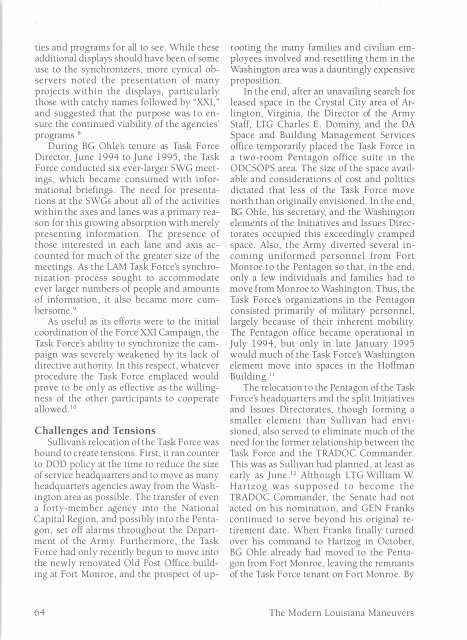The Modern Louisiana Maneuvers - US Army Center Of Military History
The Modern Louisiana Maneuvers - US Army Center Of Military History
The Modern Louisiana Maneuvers - US Army Center Of Military History
You also want an ePaper? Increase the reach of your titles
YUMPU automatically turns print PDFs into web optimized ePapers that Google loves.
ties and programs for all to see. While these<br />
additional displays should have been of some<br />
use to the synchronizers, more cynical observers<br />
noted the presentation of many<br />
proj ects within the displays, particularly<br />
those with catchy names followed by "XXI,"<br />
and suggested that the purpose was to ensure<br />
the continued viability of the agencies'<br />
programs 8<br />
During BG Ohle's tenure as Task Force<br />
Director, June 1994 to June 1995, the Task<br />
Force conducted six ever-larger SWG meetings,<br />
which became consumed with informational<br />
briefings. <strong>The</strong> need for presentations<br />
at the SWGs about all of the activities<br />
within the axes and lanes was a primary reason<br />
for this growing absorption with merely<br />
presenting information. <strong>The</strong> presence of<br />
those interested in each lane and axis accounted<br />
for much of the greater size of the<br />
meetings. As the LAM Task Force's synchronization<br />
process sought to accommodate<br />
ever larger numbers of people and amounts<br />
of information, it also became more cumbersome<br />
9<br />
As useful as its efforts were to the initial<br />
coordination of the Force XXI Campaign, the<br />
Task Force's ability to synchronize the campaign<br />
was severely weakened by its lack of<br />
directive authority. In this respect, whatever<br />
procedure the Task Force emplaced would<br />
prove to be only as effective as the willingness<br />
of the other participants to cooperate<br />
allowed.lo<br />
Challenges and Tensions<br />
Sullivan's relocation of the Task Force was<br />
bound to create tensions. First, it ran counter<br />
to DOD policy at the time to reduce the size<br />
of service headquarters and to move as many<br />
headquarters agencies away from the Washington<br />
area as possible. <strong>The</strong> transfer of even<br />
a forty-member agency into the National<br />
Capital Region, and possibly into the Pentagon,<br />
set off alarms throughout the Department<br />
of the <strong>Army</strong>. Furthermore, the Task<br />
Force had only recently begun to move into<br />
the newly renovated Old Post <strong>Of</strong>fice building<br />
at Fort Monroe, and the prospect of up-<br />
64<br />
rooting the many families and civilian employees<br />
involved and resettling them in the<br />
Washington area was a dauntingly expensive<br />
proposition.<br />
In the end, after an unavailing search for<br />
leased space in the Crystal City area of Arlington,<br />
Virginia, the Director of the <strong>Army</strong><br />
Staff, LTG Charles E. Dominy, and the DA<br />
Space and Building Management Services<br />
office temporarily placed the Task Force in<br />
a two-room Pentagon office suite in the<br />
ODCSOPS area. <strong>The</strong> size of the space available<br />
and considerations of cost and politics<br />
dictated that less of the Task Force move<br />
north than originally envisioned. In the end,<br />
BG Ohle, his secretary, and the Washington<br />
elements of the Initiatives and Issues Directorates<br />
occupied this exceedingly cramped<br />
space. Also, the <strong>Army</strong> diverted several incoming<br />
uniformed personnel from Fort<br />
Monroe to the Pentagon so that, in the end,<br />
only a few individuals and families had to<br />
move from Monroe to Washington. Thus, the<br />
Task Force's organizations in the Pentagon<br />
consisted primarily of military personnel,<br />
largely because of their inherent mobility.<br />
<strong>The</strong> Pentagon office became operational in<br />
July 1994, but only in late January 1995<br />
would much of the Task Force's Washington<br />
element move into spaces in the Hoffman<br />
BUilding. II<br />
<strong>The</strong> relocation to the Pentagon of the Task<br />
Force's headquarters and the split Initiatives<br />
and Issues Directorates, though forming a<br />
smaller element than Sullivan had envisioned,<br />
also served to eliminate much of the<br />
need for the former relationship between the<br />
Task Force and the TRADOC Commander.<br />
This was as Sullivan had planned, at least as<br />
early as June.l2 Although LTG William W<br />
Hartzog was supposed to become the<br />
TRADOC Commander, the Senate had not<br />
acted on his nomination, and GEN Franks<br />
continued to serve beyond his original retirement<br />
date. When Franks finally turned<br />
over his command to Hartzog in October,<br />
BG Ohle already had moved to the Pentagon<br />
from Fort Monroe, leaving the remnants<br />
of the Task Force tenant on Fort Monroe. By<br />
<strong>The</strong> <strong>Modern</strong> <strong>Louisiana</strong> <strong>Maneuvers</strong>
















